The Long and Winding Arms
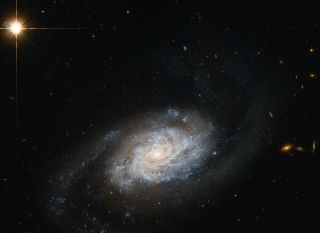
Wednesday, April 16, 2014: Spiral galaxy NGC 3455 lies roughly 65 million light-years away from us in the constellation of Leo (The Lion). NGC 3455 falls into the category of type SB galaxy — a barred spiral — in the Hubble classification system, the Hubble Sequence. Galaxies of this type appear to have a bar of stars slicing through the bulge of stars in their centers. Further, this galaxy is considered a SBb type, which means its spiral arms neither wind tightly nor loosely. NGC 3455 makes up a pair of galaxies with its partner, NGC 3454 (out of frame). This cosmic duo belong to the NGC 3370 group.
— Tom Chao
Tadpole (Not in a Jar)
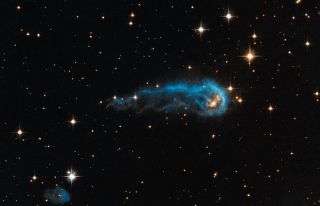
Thursday, April 17, 2014: NASA's Hubble Space Telescope viewed “the Tadpole,” a clump of gas and dust making its way through Cygnus OB2 association, a loose cluster of stars some 4,700 light-years from Earth in the constellation Cygnus. This clump of gas and dust has given birth to protostars, which represent the earliest steps in building a star. The glowing yellow one in the "head" is the most luminous and massive. Nearby stars firing ultraviolet radiation at IRAS 20324+4057 creates the intense blue glow, which also sculpts its tail into a long, wiggly shape. This clump stretches roughly a light-year from head to tail-tip, and contains gas weighing almost four times the mass of the sun.
— Tom Chao
Sky and Telescope
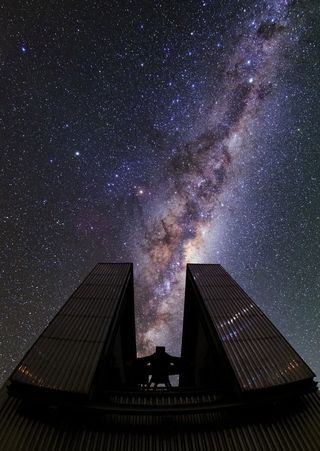
Friday, April 18, 2014: The Milky Way’s central region glows above the 3.58-meter New Technology Telescope (NTT) at ESO's La Silla Observatory, sitting at 7900 feet (2400 meters) above sea level on the outskirts of the Chilean Atacama Desert. The distinctive octagonal enclosure that houses the NTT looms tall here, and this telescope housing represented a technological breakthrough upon completion in 1989. The bright orange star Antares at the heart of Scorpius (The Scorpion) appears to the left of the Milky Way. Saturn shines as the brightest point to the upper left of Antares, while Alpha and Beta Centauri wink in the upper right of the image. Image released April 14, 2014.
— Tom Chao
Blast It!
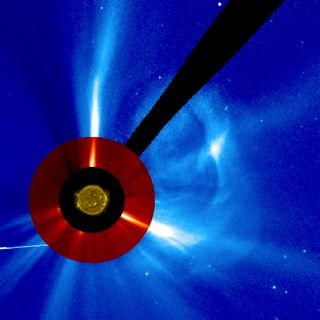
Monday, April 21, 2014: A coronal mass ejection (CME) associated with a solar flare blew out a cloud of particles to the right of the sun, from an active region at its edge, later followed by a secondary blast aimed slightly lower over about a 24-hour period during Apr. 18-19, 2013. This image comes from a video taken by the Solar and Heliospheric Observatory (SOHO) in extreme UV light. Researchers superimposed the image on top of SOHO's C2 (red) and C3 (blue) coronagraph images. The black, diagonal feature is the strut that holds the disk occulting the sun in C3.
— Tom Chao
I’m a Few Years Older Than You
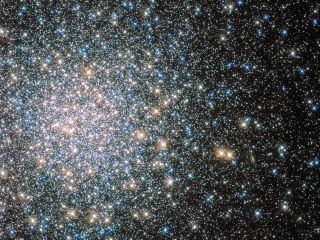
Tuesday, April 22, 2014: Messier 5 shines as a globular cluster consisting of hundreds of thousands of stars bound by their collective gravity. Messier 5, unlike other globular clusters, dates back to close to the beginning of the universe, at some 13.8 billion years of age. It also represents one of the biggest clusters known, lying at a relatively close distance of only 24,500 light years away, making it a popular target for astronomers. Strangely, Messier 5 should, at its advanced age, consist of old, low-mass red giants and other ancient stars. However, it harbors many young blue stars known as “blue stragglers.” These stars emerge when stars collide or rip material from others.
— Tom Chao
Didn’t I Blow Your Mind This Time?
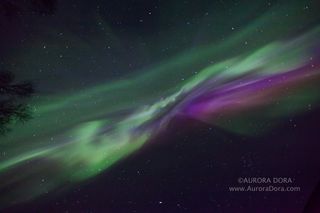
Wednesday, April 23, 2014: Astrophotographer Dora Miller sent in a photo of an auroral display over Alaska, taken April 20, 2014. She writes in an email message to Space.com: "A very intense and colorful show of northern lights happened last night here in Alaska. I have been shooting auroras for many years but last night was a mind blower." Miller is based in Talkeetna, AK.
— Tom Chao
Crater on Mercury
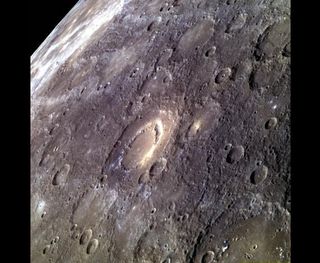
Thursday, April 24, 2014: MESSENGER spacecraft in orbit around Mercury obtained this image of the peak-ring basin Scarlatti (center) on March 30, 2014. Scarlatti has ring of peaks at its center, typical in many respects, although in the northeast section, it transitions to a large (approximately 19 miles or 30 km) pit surrounded by high-reflectance material. Past explosive volcanic activity may have created this pit.
— Tom Chao
Get the Space.com Newsletter
Breaking space news, the latest updates on rocket launches, skywatching events and more!
Just Wave Hello

Friday, April 25, 2014: Astronaut Koichi Wakata tweeted this photo of one of two NASA astronauts spacewalking on April 23, 2014. He wrote: "Rick [Mastracchio] and Steve [Swanson] did a fantastic job on the spacewalk today."
— Tom Chao
Down the Shore Everything's All Right
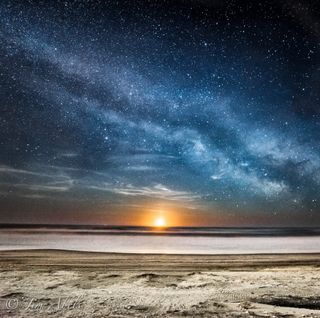
Monday, April 26, 2014: Astrophotographer Jim Abels traveled to Ocean City, New Jersey, to capture this moonrise and the Milky Way. Abels writes in an email to Space.com: “I travelled to the bottom of NJ to get away from the impeding light pollution to capture the coming meteor shower … instead, I captured a beautiful moonrise over the Atlantic Ocean with the Milky Way hovering above.” Image submitted April 25, 2014.
— Tom Chao
How to Capture Your Dragon
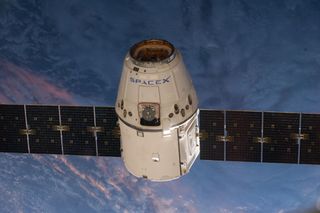
Tuesday, April 29, 2014: This photo documented the arrival and ultimate capture and berthing of the SpaceX Dragon at the International Space Station, as photographed by an Expedition 39 crew member onboard the orbital outpost. The space station successfully captured the spacecraft, following its arrival on April 20, 2014.
— Tom Chao
Join our Space Forums to keep talking space on the latest missions, night sky and more! And if you have a news tip, correction or comment, let us know at: community@space.com.











